How to Plant a Lemon Tree: Essential Tips for Growth and Care
- February 6, 2024
- 0 comment
Learn to plant a lemon tree with our easy guide. From selecting the right spot to care tips, grow your lemons successfully. Embarking on the journey to plant a lemon tree is a rewarding venture that promises the sweet scent of blossoms and the tang of fresh fruit right from your backyard. This comprehensive guide is designed to take you step by step through the process, ensuring that even beginners can achieve success.
From choosing the perfect location to mastering the art of care, we’ve got all the essentials covered. Whether you’re looking to enhance your garden’s beauty or to enjoy homegrown lemons, let’s dive into the world of lemon tree planting and turn your gardening dreams into reality.
List of Guides on How to Plant a Lemon Tree
- Choose the Right Variety
- Select a Planting Site
- Prepare the Soil
- Dig the Planting Hole
- Plant Your Lemon Tree
- Backfill the Hole
- Mulch and Water
- Stake the Tree
- Water Regularly
- Fertilize
Understanding Lemon Trees

Lemon trees symbolize vitality and freshness, flourishing under the right conditions to provide bountiful harvests. Before you start, it’s essential to select a variety that matches your climate and space. The Meyer lemon, for instance, is celebrated for its sweeter, less acidic fruit and compact growth, ideal for indoor or small-space gardeners. In contrast, the Eureka and Lisbon varieties, known for their classic sharp lemon flavor, thrive outdoors in warmer climates. Understanding these differences is the first step to ensuring your lemon tree not only survives but thrives.
Different Types of Lemon Trees
1. Eureka Lemon: Eureka lemons have a classic lemon appearance with bright yellow skin and a few seeds. They are known for their year-round abundant fruit production.
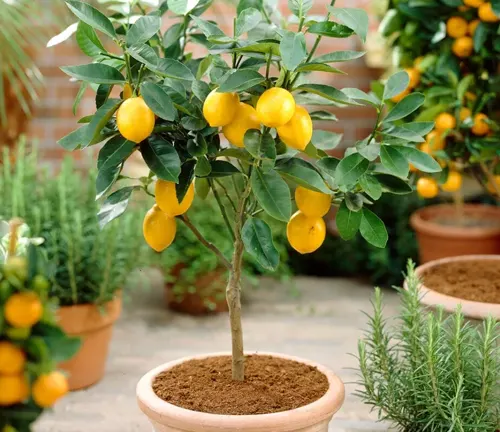
- Growth Habit: This variety tends to grow vigorously and can become quite large. It’s well-suited to warm climates and is often found in commercial orchards.
- Use: Ideal for culinary uses due to its acidic, tangy flavor.
2. Lisbon Lemon: Similar to the Eureka, Lisbon lemons are also seedless, very juicy, and have a strong, tangy taste. They have more textured skin and are less rounded.
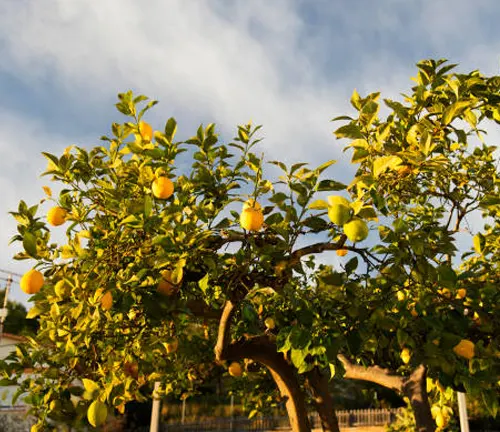
- Growth Habit: Lisbon trees are hardier than Eureka, making them more resistant to cold and heat. They also produce fruit mostly in the winter and early spring.
- Use: Perfect for cooking and baking due to their high juice content and strong lemon flavor.
3. Meyer Lemon: Meyer lemons are a sweeter, less acidic variety with a thin skin and a deep yellow to orange hue. They are smaller and rounder than other lemons and contain few seeds.
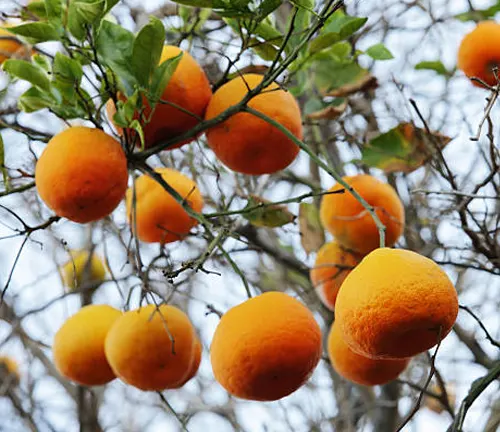
- Growth Habit: These trees are more compact, making them suitable for container gardening or smaller spaces. They are also more cold-tolerant than other lemon varieties.
- Use: Their mild flavor makes them versatile for both culinary and beverage uses, from lemonades to desserts.
4. Ponderosa Lemon: Ponderosa lemons are large, with a thick, bumpy rind. They are not true lemons but a lemon-citron hybrid, with a juicy and acidic flesh.
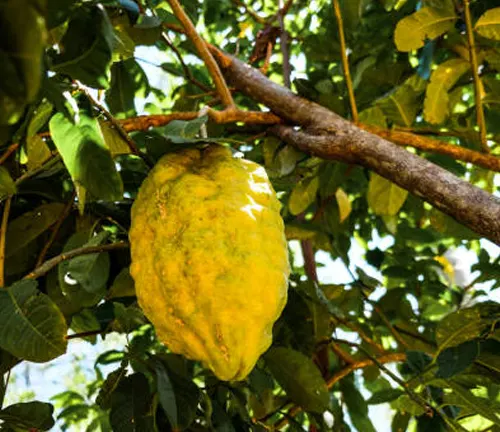
- Growth Habit: This variety is more of an ornamental tree due to its large, attractive fruit and foliage. It grows well in containers and indoors.
- Use: Due to its size and acidity, it’s often used in the same way as traditional lemons, though its large seeds and thick peel are considerations in its culinary application.
5. Pink Variegated Lemon: This lemon variety is known for its variegated (green and white) leaves and pink-fleshed fruit, which turns yellow when ripe. The lemons have a tangy taste with a slight sweetness.
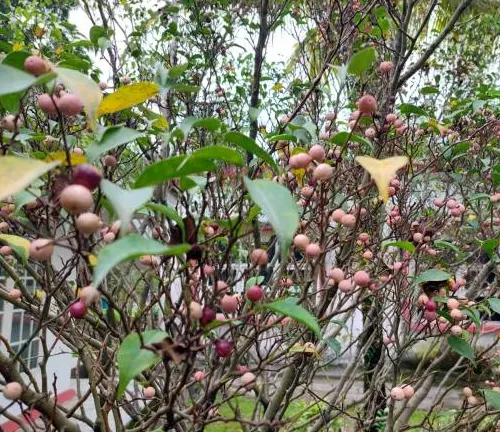
- Growth Habit: The tree is relatively small and highly ornamental, making it suitable for landscaping and container gardening.
- Use: Its unique color and mild flavor make it a favorite for decorative use in dishes and drinks, as well as in marmalades and desserts.
Pre-Planting Considerations
Selecting the Right Location
Lemon trees thrive in sunny, well-drained spots. They require at least six to eight hours of sunlight daily. The ideal soil is slightly acidic to neutral. If your garden space doesn’t naturally meet these conditions, consider adjustments like raised beds or proper amendments to ensure your tree’s success.
When to Plant
Timing is key in planting lemon trees. Generally, spring is the best season, allowing the tree to establish itself before facing the summer heat or winter cold. However, in warmer climates, planting can extend into fall.
Planting Your Lemon Tree
Tools and Materials Needed
- Lemon Tree Sapling: Choose a healthy sapling from a reputable nursery, selecting a variety that suits your climate and space.
- Spade or Shovel: For digging the planting hole.
- Garden Fork: Useful for loosening the soil in and around the planting hole.
- Compost: To enrich the planting hole and improve soil structure and fertility.
- Organic Mulch: Such as bark chips, straw, or leaves, to retain soil moisture and suppress weeds.
- Watering Can or Garden Hose: For deep watering right after planting and for regular watering thereafter.
- Wheelbarrow (optional): Helps with transporting soil, compost, and mulch to the planting site.
- Gardening Gloves: To protect your hands while working.
- Soil pH Tester: To check the soil’s pH level, ensuring it’s suitable for your lemon tree.
- Stakes and Soft Ties (if necessary): For staking the tree if you live in a windy area or if the sapling needs extra support.
- Root Stimulator (optional): A product designed to encourage strong root growth after planting.
- Citrus Fertilizer: A fertilizer formulated specifically for citrus trees, to provide the necessary nutrients for your lemon tree.
- Pest and Disease Control Supplies: Depending on your area, you might need organic or chemical controls to manage pests and diseases.
Step 1: Choose the Right Variety
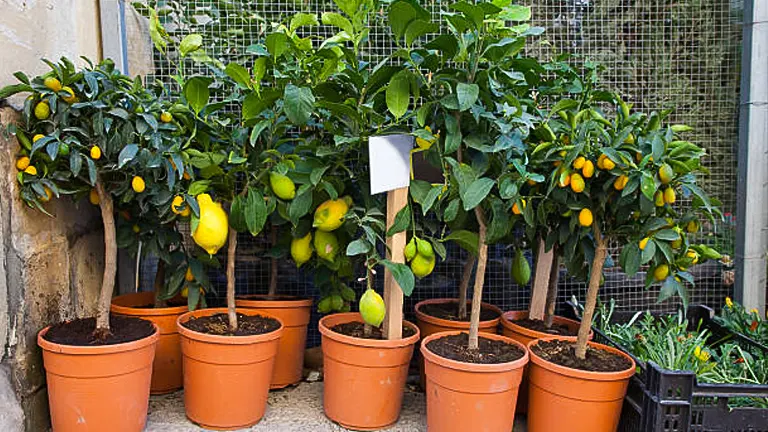
Picking the right type of lemon tree is crucial. In cooler areas, go for a Meyer lemon tree because it can handle the cold better. Meyer lemons also taste sweeter. If you live somewhere warmer, consider Eureka or Lisbon lemons. These types do well in heat and give you the classic lemon taste.
Tip:
- Meyer lemons can grow indoors with enough light, making them versatile for various settings.
- Eureka and Lisbon lemons need more space due to their larger size, so plan your garden space accordingly.
- Check the fruiting season of each variety to match your harvesting preferences.
- Consider the tree’s mature size, not just where it fits now, to avoid overcrowding as it grows.
- Local nursery staff can offer valuable advice on the best variety for your area’s climate and soil conditions.
- Look into the tree’s water needs; while all lemon trees need regular watering, some varieties may require slightly more or less.
- Soil quality affects growth; enrich your planting area with compost regardless of the variety you choose.
Step 2: Select a Planting Site

Lemon trees require a lot of sunlight to grow strong and produce fruit, so find a spot in your garden that gets at least 6-8 hours of direct sunlight every day. The location should also have soil that drains well. If water sits too long around the roots, it can cause root rot, a common problem that can severely affect your tree’s health.
Tip:
- Test your soil’s drainage by digging a hole about a foot deep and filling it with water. If the water doesn’t drain within an hour, your soil may have poor drainage, and you might need to improve it or choose a different location.
- If you’re limited in space or have poor soil, consider planting your lemon tree in a large container with drainage holes and using a high-quality potting mix. This allows you to control the soil quality more effectively.
- South or west-facing spots are typically the sunniest parts of the garden, making them ideal locations for your lemon tree.
- Protect your lemon tree from strong winds by planting it near a wall or fence if possible. Wind can stress the tree and cause damage or loss of fruit.
- Check the pH of your soil; lemon trees prefer slightly acidic to neutral soil (pH 6.0-7.0). You can amend the soil with sulfur or lime to adjust the pH if necessary.
- Keep future growth in mind; ensure there’s enough room for the tree to expand without interfering with buildings, power lines, or other plants.
- Consider accessibility for care and harvesting. Planting your lemon tree in a convenient location will make it easier to water, prune, and collect fruit.
Step 3: Prepare the Soil
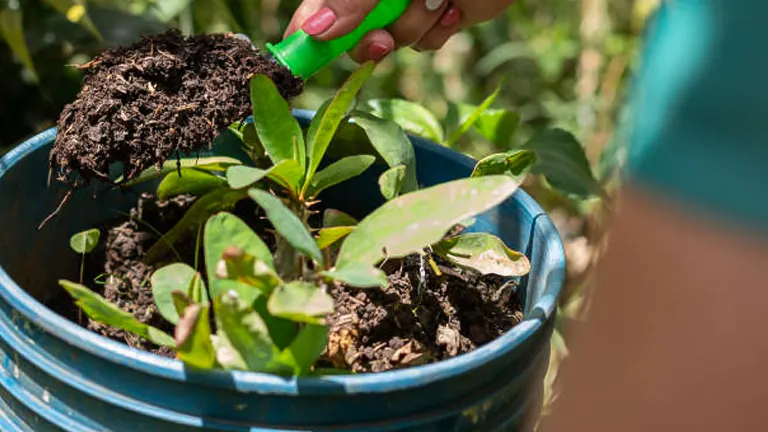
Preparing the soil correctly is a critical step in ensuring the successful growth of your lemon tree. Start by amending the planting area with compost. This enriches the soil, adding essential nutrients that will help your tree thrive. If you’re dealing with particularly sandy soil, which drains too quickly, or heavy clay soil, which retains too much water, incorporating organic matter is key to balancing the soil’s structure and improving its nutrient content.
Tip:
- Mix in well-aged compost or worm castings to introduce beneficial microorganisms that promote root health and nutrient absorption.
- If dealing with sandy soil, incorporate peat moss to enhance moisture retention without compacting the soil.
- For clay soils, adding gypsum can help break up the clay, improving water penetration and root growth.
- Regularly check the moisture level in the soil after amending it. Proper moisture is crucial for young trees but be careful not to overwater.
- Create a slight mound or raised area for planting if drainage is a concern, ensuring water moves away from the base of the tree.
- Aerate compacted soil around the planting site to improve oxygen flow to the roots, crucial for the tree’s overall health.
- Mulch around the base of the tree after planting, leaving a gap around the trunk to prevent moisture buildup and discourage pests.
Step 4: Dig the Planting Hole
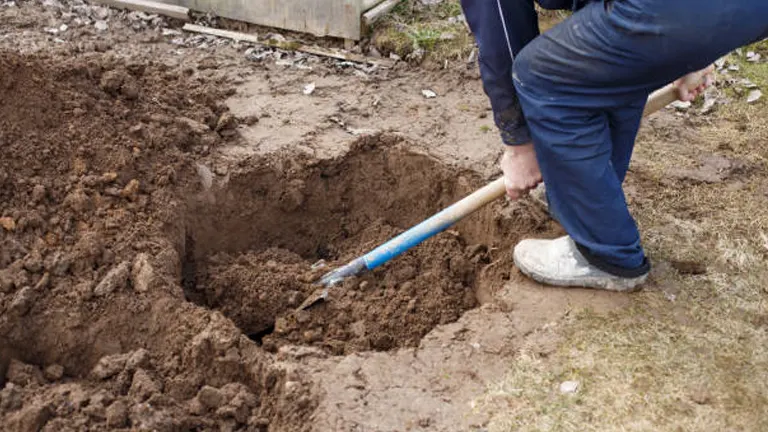
The hole should be twice as wide as the root ball of your tree but only as deep. This size ensures that the roots have enough room to spread out without struggling against compacted soil, which can hinder their growth and the overall health of the tree.
Tip:
- Before you start digging, water the area lightly to soften the soil, making it easier to work with and lessening root damage during planting.
- Use a sharp spade or shovel to create clean edges; this makes it easier for roots to penetrate the surrounding soil.
- If the soil is very compacted, roughen the sides and bottom of the hole with a fork to encourage root growth beyond the initial planting area.
- Place the excavated soil on a tarp or in a wheelbarrow to prevent making a mess and to facilitate mixing it with compost before backfilling.
- Check the depth of the hole by placing a stick or shovel handle across the top and measuring the distance to the bottom. The goal is to have the tree sit at the same level it was growing in its pot or nursery.
- If planting multiple lemon trees, ensure they are spaced adequately apart to allow for mature growth, generally 15-20 feet between trees, depending on the variety.
- After digging, fill the hole with water and let it drain. This tests the drainage rate and pre-moistens the area for the roots.
Step 5: Plant Your Lemon Tree

Planting your lemon tree correctly is essential for its success. Start by carefully removing the tree from its container to minimize stress and damage to the roots. If you notice the roots are tightly wound around the soil (a condition known as being “pot-bound”), gently loosen them. This encourages the roots to spread into the surrounding soil instead of continuing to grow in a circle. When placing your tree in the prepared hole, make sure the top of the root ball is level with the surrounding ground. This ensures that your tree isn’t planted too deeply, which can lead to waterlogging and root diseases, or too shallow, which can expose roots to drying out.
Tip:
- If the root ball is dry, water it thoroughly before planting to ensure the roots are well-hydrated.
- When placing the tree in the hole, orient it so the best side faces the direction you’ll view it from most often.
- Fill the planting hole halfway with soil, then water it to settle the soil around the roots before filling it in completely. This removes air pockets and ensures good root-soil contact.
- After planting, create a water well around the base of the tree by mounding soil in a circle a few feet out from the trunk. This helps direct water to the root zone when you water the tree.
- Avoid adding fertilizer directly into the planting hole, as it can burn the roots. Wait until the tree has been established for a few weeks before applying a balanced, slow-release fertilizer formulated for citrus trees.
- Gently tamp the soil around the tree with your hands (not your feet) to firm it in place, but be careful not to compact the soil too much, which can prevent air and water from reaching the roots.
Step 6: Backfill the Hole

After positioning your lemon tree in the planting hole, the next step is to backfill the hole. This process involves refilling the hole with a mixture of the soil you removed and compost. The compost enriches the soil, providing your tree with vital nutrients needed for healthy growth. As you backfill, press the soil down gently around the roots to eliminate air pockets. These air pockets can dry out roots and hinder water and nutrient absorption. After backfilling, water the area deeply. This helps settle the soil around the roots and ensures that your tree has adequate moisture to start its acclimation process in its new environment.
Tip:
- Layer the soil and compost mix around the roots in stages, watering lightly at each stage to help settle the soil and eliminate air gaps.
- Ensure the final soil level matches the surrounding ground level to prevent water from pooling around the trunk, which could lead to rot.
- After backfilling, form a shallow basin around the tree by mounding soil in a ring at the edge of the root zone. This basin will help to catch and direct water to the tree’s roots, ensuring deep water penetration.
- In the first few weeks, monitor the soil moisture closely. The goal is to keep the soil consistently moist but not waterlogged, as new roots are especially sensitive to drying out and overwatering.
- If you’re planting in a windy area, protect the newly planted tree with a windbreak or by staking. This prevents the tree from rocking in the wind, which can loosen the soil around the roots and slow establishment.
- Mulch around the tree with an organic mulch to conserve moisture, regulate soil temperature, and reduce weed competition. Keep the mulch a few inches away from the trunk to avoid moisture buildup against the bark.
Step 7: Mulch and Water
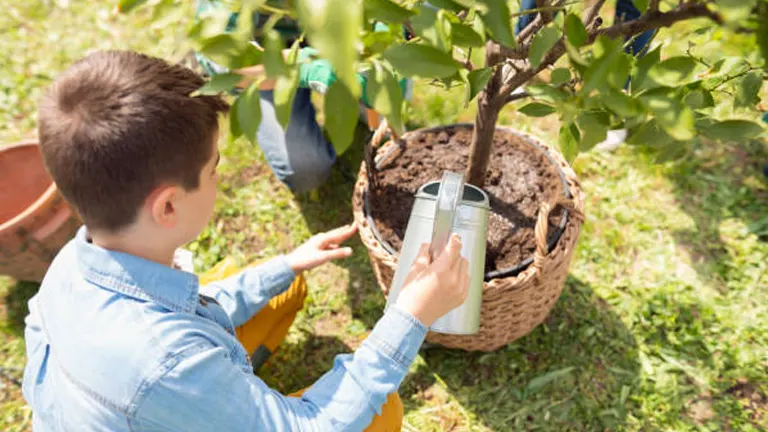
Use organic mulch, such as bark chips or straw, and spread it in a 2-3 inch layer around the base of the tree. It’s important to leave a gap between the mulch and the tree trunk to prevent excess moisture from accumulating, which could lead to trunk rot.
Tip:
- Choose a mulch that complements your garden’s aesthetic while providing the practical benefits. Organic mulches break down over time, adding nutrients back into the soil.
- After mulching, water the tree deeply to encourage the roots to grow downward in search of moisture, which helps establish a strong root system.
- Use a soaker hose or drip irrigation to apply water directly to the root zone, minimizing water waste and reducing the risk of leaf diseases that can occur with overhead watering.
- Monitor the soil moisture regularly, especially during dry spells. The goal is to keep the soil moist but not soggy. Overwatering can be as harmful as under-watering, leading to oxygen-deprived roots.
- In the first year, focus on establishing the tree with consistent watering, adjusting your schedule based on rainfall, temperature, and soil type. Young trees may need water 2-3 times a week during hot, dry periods.
- As the tree grows, reduce the frequency of watering to encourage deeper root growth, which makes the tree more drought-resistant and sturdy.
Step 8: Stake the Tree (if necessary)
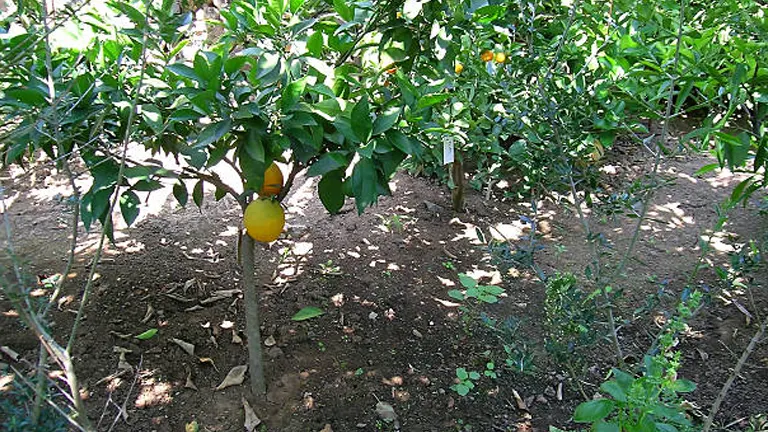
Staking a newly planted lemon tree can be crucial for its stability and growth, especially in locations prone to strong winds. The goal is to provide enough support to prevent the tree from bending or breaking, without inhibiting its natural growth and strengthening processes.
Tip:
- Select a stake that’s tall and sturdy enough to support the tree’s height and provide stability against wind. A metal or wooden pole around 5-6 feet in height is ideal.
- Install the stake 6-8 inches from the tree trunk towards the prevailing wind direction to counteract the wind’s force effectively.
- Use soft, flexible materials like tree ties, rubber tubing, or old pantyhose to secure the tree to the stake. This prevents bark damage and allows some movement, which is crucial for developing trunk strength.
- Periodically check the ties as the tree grows to ensure they’re not too tight. Loosen them as necessary to accommodate the tree’s increasing diameter without restricting growth.
- Keep an eye on the tree’s stability, especially during the first year. If the tree begins to lean or shows signs of stress, adjust the staking or add more support as needed.
- Remember to remove the stake after the first year or once the tree is stable enough to withstand wind on its own. Prolonged staking can hinder the development of a strong, self-supporting trunk.
Step 9: Water Regularly
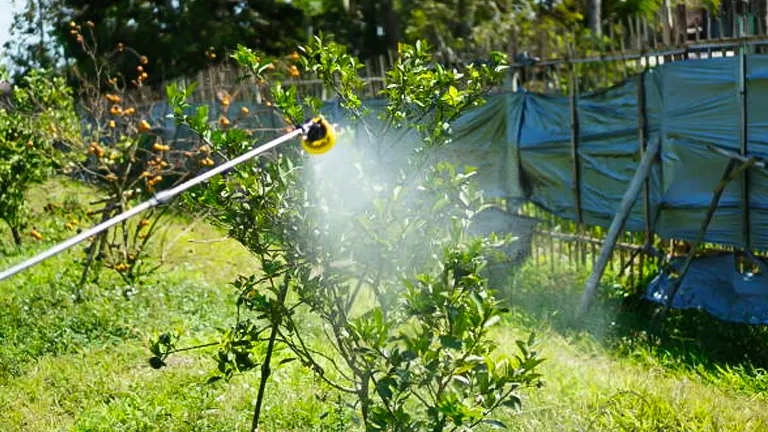
Ensuring your lemon tree receives the right amount of water is critical for its health and fruit production. Lemon trees need a consistent supply of moisture, particularly in their formative years, but it’s important to balance this with good drainage to prevent root issues.
Tip:
- Water your lemon tree deeply to encourage deep root growth. This means allowing water to penetrate several inches into the soil, reaching the entire root system.
- Check the soil moisture by feeling it a few inches below the surface. If the top 2-3 inches of soil are dry, it’s time to water.
- In hot, dry periods, young lemon trees may need water 2-3 times a week. Adjust your watering frequency based on rainfall, temperature, and the tree’s growth stage.
- Use a soaker hose or drip irrigation system to apply water directly to the base of the tree. This method reduces water waste and prevents water from sitting on the leaves, which can lead to fungal diseases.
- Mulching around the base of your lemon tree helps retain soil moisture and keeps roots cool. Just be sure to leave a gap around the trunk to prevent rot.
- As your lemon tree matures, it will become more drought-resistant. However, during prolonged dry spells, even established trees will benefit from supplemental watering.
- Avoid overwatering, as too much moisture can be just as detrimental as not enough. Overly wet soil lacks sufficient air, which roots need to function properly.
Step 10: Fertilize
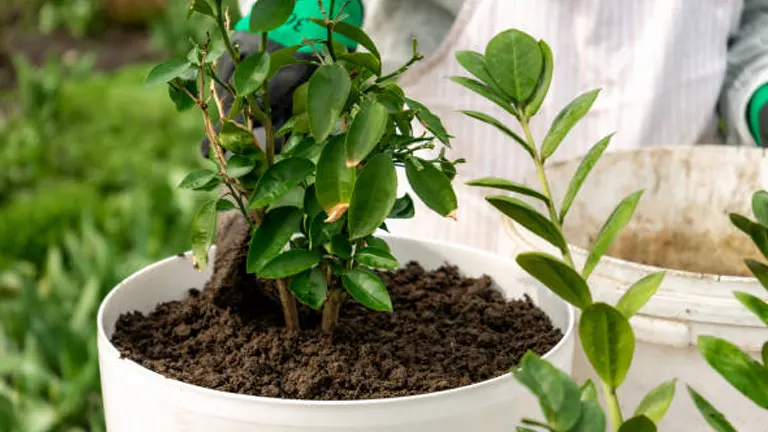
Proper fertilization is essential for the health and productivity of your lemon tree. Citrus-specific fertilizers are formulated to meet the unique nutritional needs of lemon trees, providing a balanced mix of nitrogen, phosphorus, potassium, and micronutrients.
Tip:
- Begin fertilizing in early spring, as new growth appears. This kick-starts the growing season by providing necessary nutrients when the tree is most receptive.
- Follow the recommended application rates on the fertilizer package. Over-fertilizing can harm your tree by burning the roots and affecting fruit quality.
- Apply fertilizer around the drip line of the tree rather than directly at the base. This encourages roots to spread out in search of nutrients, promoting a healthier root system.
- Water the tree thoroughly after applying fertilizer to help dissolve and distribute the nutrients into the soil.
- Consider supplementing granular fertilizers with foliar sprays that provide micronutrients like zinc, manganese, and iron, especially if your soil test indicates deficiencies.
- Fertilize your lemon tree every few months during the growing season, tapering off in late summer to early fall. This allows your tree to harden off and prepare for winter without promoting new growth susceptible to frost damage.
- Observe your tree’s growth and leaf color. Dark green, glossy leaves and steady growth are good indicators that your fertilization regimen is on point. Yellowing leaves or stunted growth may indicate nutrient deficiencies or other issues.
Container Planting
If your space or soil isn’t ideal, container planting offers a flexible alternative. Choose a large pot with drainage holes and fill it with a potting mix designed for citrus trees. The same planting principles apply, but with the added benefit of mobility. You can move your tree to optimize sunlight exposure and protect it from harsh weather.
Tips:
- Ensure the container is large enough to accommodate the tree’s growth; a pot at least 18-24 inches in diameter is a good start.
- Use a high-quality, well-draining potting mix specifically formulated for citrus or fruit trees to ensure proper nutrition and moisture management.
- Position the pot in a location that receives at least 6-8 hours of direct sunlight daily. Use a dolly or plant caddy underneath for easier mobility.
- Water more frequently than in-ground trees, as container plants tend to dry out faster, especially in warm weather.
- Monitor for drainage after watering; excess water should flow freely out of the bottom to avoid waterlogged roots.
- Fertilize regularly with a citrus-specific fertilizer, following the recommended dosage for container plants, which may differ from in-ground trees.
- Prune to maintain shape and size, especially important in confined spaces to ensure your lemon tree remains manageable and healthy.
- Protect from extreme temperatures by moving the container to a sheltered location during cold snaps or intense summer heat.
Post-Planting Care
Watering
Watering correctly is crucial for your lemon tree’s success. Young trees need consistent moisture as they establish, but overwatering can be as detrimental as under-watering. Aim for a balance, allowing the soil to dry slightly between waterings. The frequency will depend on your climate, soil, and the season.
Feeding
Feeding your lemon tree ensures it has the nutrients needed for growth and fruit production. Use a fertilizer formulated for citrus trees, applying in early spring and summer to support the growing season’s demands.
Pruning
Pruning is not just about shaping; it’s about maintaining the health of your tree. Remove any dead or damaged branches to prevent disease and improve air circulation. Light pruning can also encourage fruit production. However, be cautious not to over-prune, as this can stress the tree and reduce yield.
Troubleshooting Common Problems
Even with the best care, challenges can arise. Pests, diseases, and environmental stresses are common issues lemon tree growers face. Regularly inspect your tree for signs of distress and address problems early. Natural remedies and proper gardening practices can often mitigate these issues without resorting to harsh chemicals. Here are some typical issues:
- Yellowing Leaves: Often a sign of nutrient deficiency, particularly nitrogen. It can also indicate overwatering or poor drainage. Ensure your tree is being fertilized correctly and that the soil allows for proper moisture management.
- Leaf Drop: Stress from either overwatering or underwatering can cause leaf drop. Consistent soil moisture is key. Check the soil’s moisture level before watering and adjust your schedule according to weather conditions and the tree’s growth stage.
- Pests: Common pests include aphids, spider mites, and scale insects. They typically gather on the undersides of leaves and along stems. Use insecticidal soap or neem oil for an eco-friendly treatment option. Regularly inspect your tree for early signs of infestation to manage pests before they cause significant damage.
- Diseases: Fungal diseases like citrus canker and root rot are common. Citrus canker causes lesions on leaves, stems, and fruit, while root rot affects the tree’s roots and base. Prevent diseases by ensuring proper spacing, air circulation, and soil drainage. Remove and destroy affected parts, and consider fungicidal treatments as recommended by local agricultural extensions.
- Fruit Drop: Premature fruit drop can be caused by environmental stress, such as extreme temperatures, irregular watering, or nutrient imbalances. Maintain consistent care, protect trees from extreme weather, and ensure they are receiving balanced nutrition.
- Sunburn: The bark of young trees or newly exposed branches can suffer from sunburn, leading to cracking or peeling bark. Protect trees with tree wraps or use whitewash on the trunk and exposed branches.
- Nutrient Deficiencies: Besides nitrogen deficiency indicated by yellow leaves, magnesium or iron deficiencies can also affect lemon trees, showing as yellowing between leaf veins. Applying Epsom salts for magnesium and chelated iron for iron deficiency can help address these issues. Always base nutrient applications on soil test results.
By monitoring your lemon tree for these common problems and addressing them promptly with the appropriate measures, you can help ensure your tree remains healthy and productive. Regular care, including proper watering, fertilization, and pest management, will go a long way in preventing these issues.
Maintenance and Care Tips for Your Lemon Tree
- Watering Needs: Lemon trees require consistent moisture but dislike waterlogged roots. Water deeply when the top 2-3 inches of soil become dry. In hotter months, this might mean watering 2-3 times a week, while in cooler months, less frequent watering is necessary. The goal is to maintain evenly moist soil without over-saturating it.
- Sunlight Exposure: Lemon trees thrive in full sun, needing at least 6-8 hours of direct sunlight per day. If your tree is indoors or in a pot, rotate it regularly to ensure all sides receive equal light, promoting even growth and fruiting.
- Soil and Fertilization: Use well-draining soil and fertilize your lemon tree with a citrus-specific fertilizer according to the package instructions, typically every few months during the growing season. These fertilizers are balanced to meet the nutritional needs of citrus trees, supporting leaf growth and fruit production.
- Pruning: Prune your lemon tree to remove dead or diseased branches, thin out crowded areas to improve airflow, and shape the tree for better light penetration. This helps prevent disease and encourages more fruitful branches. The best time to prune is after the tree has finished fruiting, usually in late winter or early spring.
- Pest and Disease Management: Keep an eye out for common pests like aphids, spider mites, and scale insects, as well as diseases such as citrus canker or greening. Use organic pest control methods like neem oil or insecticidal soap as a first line of defense. Proper pruning and cleanliness around the tree can prevent many issues.
- Mulching: Apply a 2-3 inch layer of organic mulch around the base of your lemon tree to help retain soil moisture, regulate soil temperature, and suppress weeds. Keep the mulch a few inches away from the trunk to avoid moisture buildup that could lead to fungal diseases.
- Winter Protection: If you live in a region with cold winters, protect your lemon tree from frost. For trees planted in the ground, cover them with frost cloth or burlap. Container-grown trees should be moved to a protected area, like a garage or indoors near a sunny window, when frost is expected.
- Regular Monitoring: Regularly inspect your lemon tree for signs of stress, such as yellowing leaves or stunted growth, which could indicate watering issues, nutrient deficiencies, or pest and disease problems. Early detection and treatment can prevent minor issues from becoming major problems.
Conclusion
Planting a lemon tree is a journey of growth, not just for the tree, but for the gardener as well. With patience, care, and a bit of gardening know-how, you can cultivate a thriving lemon tree that rewards you with bountiful harvests for years to come. Embrace the process, and enjoy the fruits of your labor—both literally and metaphorically.
FAQs
- What’s the ideal soil pH for a lemon tree?
Lemon trees thrive in slightly acidic soil, ideally with a pH between 6.0 and 7.0. Test your soil and amend it with sulfur or lime if needed to reach this range. - How can I tell if my planting site has good drainage?
Perform a drainage test by digging a hole about 1 foot deep, filling it with water, and observing how long it takes to drain. Ideally, it should drain within a few hours. - Can lemon trees grow in shaded areas if I don’t have full sun?
Lemon trees really need full sun to produce fruit abundantly. If you have partial shade, your tree may grow but fruit production will be limited. - What’s the best way to prepare the soil before planting a lemon tree?
Enrich the soil with a mix of compost and a balanced, slow-release fertilizer to provide nutrients. Also, ensure the soil is loose and well-aerated to promote healthy root growth. - How deep should I plant a lemon tree?
The hole should be twice as wide and just as deep as the root ball. Planting at the same depth as the pot ensures the transition is stress-free for the tree. - Is it necessary to prune a lemon tree immediately after planting?
No immediate pruning is necessary. Wait until the tree is established and begin pruning for shape and health in the following year. - How do I protect my lemon tree from wind damage in exposed areas?
Stake the tree during its first year or until it’s sturdy enough to withstand wind. Planting a windbreak or using a temporary fence can also help. - Can I use mulch around my lemon tree, and what type should I use?
Yes, mulching helps retain moisture and suppress weeds. Use organic mulch like bark chips or straw, keeping it a few inches away from the trunk to prevent rot.
In closing, planting a lemon tree can be a rewarding experience, offering not only the joy of growing your own fruit but also adding beauty and fragrance to your garden. By following these steps and tips, you’re well on your way to enjoying fresh lemons right from your backyard. Remember, patience and care are key. Happy gardening!

Benjamin Brooks
Forestry AuthorGreetings! I'm Benjamin Brooks, and my journey over the past 15 years has revolved around the fascinating realms of content creation, expertise in snow clearing, and the intricate world of lumberjacking and landscaping. What began as a simple curiosity about the natural world and heavy machinery has evolved into a passionate profession where my love for crafting words intertwines seamlessly with my lumberjacking and garden skills.













Leave your comment